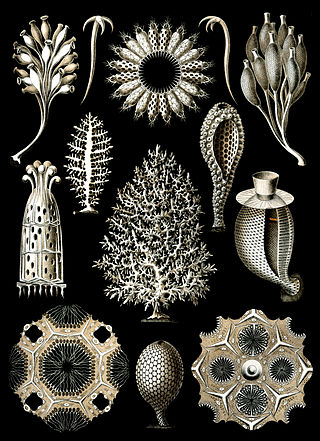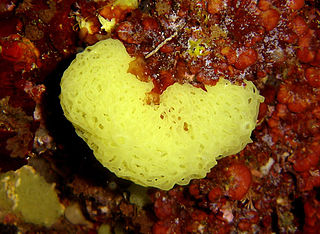
The calcareoussponges are members of the animal phylum Porifera, the cellular sponges. They are characterized by spicules made of calcium carbonate, in the form of high-magnesium calcite or aragonite. While the spicules in most species are triradiate, some species may possess two- or four-pointed spicules. Unlike other sponges, calcareans lack microscleres, tiny spicules which reinforce the flesh. In addition, their spicules develop from the outside-in, mineralizing within a hollow organic sheath.

Clathrina is a genus of calcareous sponge in the family Clathrinidae. Several species formerly in Clathrina were transferred to the newly erected genera Arturia, Ernstia, Borojevia, and Brattegardia in 2013. The name is derived from the Latin word "clathratus" meaning "latticed".
Heteropiidae is a family of sea sponges in the order Leucosolenida in the class Calcarea. In a 2012 paper, Oliver Voigt, Eilika Wülfing and Gert Wörheide (2012) confirmed that the family Heteropiidae is not monophyletic./

Hexasterophora are a subclass of glass sponges in the class Hexactinellida. Most living hexasterophorans can be divided into three orders: Lyssacinosida, Lychniscosida, and Sceptrulophora. Like other glass sponges, hexasterophorans have skeletons composed of overlapping six-rayed spicules. In addition, they can be characterized by the presence of hexasters, a type of microsclere with six rays unfurling into multi-branched structures.
Arturia compacta is a species of calcareous sponge in the family Clathrinidae found in Mauritius. This species is very likely to be synonymous with Arthuria canariensis, differing only in its larger and thicker triactines. However, the type and only known specimen is lost.
Arturia dubia is a species of calcareous sponge in the genus Arturia from Australia. The species was first described as Leucosolenia dubia by Arthur Dendy in 1891. The name is derived from Dendy's uncertainty about the validity of the species, believing his specimens could, in fact, represent juvenile Leucosolenia cavata.
Clathrina helveola is a species of calcareous sponge in the family Clathrinidae from Australia, found in coastal waters off Queensland. It was first described by Gert Wörheide and John Hooper in 1999. The species name, helveola, means "pale yellow" in Latin and refers to the species' colouration.
Clathrina heronensis is a species of calcareous sponge fin the family Clathrinidae and found in the seas around Australia, and in the coastal seas of many islands to her north. It was first described by Gert Wörheide and John Hooper in 1999.
Clathrina parva is a species of calcareous sponge in the family Clathrinidae, found off the Queensland coast of Australia.

Spicules are structural elements found in most sponges. The meshing of many spicules serves as the sponge's skeleton and thus it provides structural support and potentially defense against predators.

Arthur Dendy was an English zoologist known for his work on marine sponges and the terrestrial invertebrates of Victoria, Australia, notably including the "living fossil" Peripatus. He was in turn professor of zoology in New Zealand, in South Africa and finally at King's College London. He was a Fellow of the Royal Society.

Arturia is a genus of calcareous sponge in the family Clathrinidae which contains 14 species. It is named after Arthur Dendy, a prominent researcher of calcareous sponges. It was renamed Arturia in 2017 because the name Arthuria was already assigned to a genus of molluscs.

Soleneiscus is a genus of calcareous sponges in the family Dendyidae.
Sceptrulophora is an order of hexactinellid sponges. They are characterized by sceptrules, a type of microsclere with a single straight rod terminating at a bundle of spines or knobs. An anchor- or nail-shaped sceptrule is called a clavule. A fork-shaped sceptrule, ending at a few large tines, is called a scopule. A broom-shaped sceptrule, ending at many small bristles, is called a sarule.
Gert Wörheide is a German marine biologist who works mainly on marine invertebrates. He earned his doctorate in geobiology from Georg-August-Universität, following this with a post-doctorate at Queensland Museum (1998-2002), where he worked with John Hooper on sponges, a collaboration which continues.
Soleneiscus radovani is a species of calcareous sponge in the family Dendyidae, and was first described in 1999 by Gert Wörheide and John Hooper. The species epithet, radovani, honours Radovan Borojevic for "his substantial and pioneering achievements in calcarean taxonomy".
Leucetta villosa is a species of calcareous sponge in the family Leucettidae, and was first described in 1999 by Gert Wörheide and John Hooper. The species epithet, villosa, comes from the Latin, villosus ("hairy"), and was given because of the "hair-like extensions on the sponge surface".

Leucetta is a genus of sponges in the family Leucettidae, which was first described in 1872 by Ernst Haeckel. The type species is Leucetta primigenia Haeckel, 1872 by subsequent designation.

Leuclathrina is a genus of sponges belonging to the family Dendyidae. Species are found in the northeast Atlantic and in the Indian Ocean.
Michelle Kelly, also known as Michelle Kelly-Borges, is a New Zealand scientist who specialises in sponges, their chemistry, their evolution, taxonomy, systematics, and ecology.









